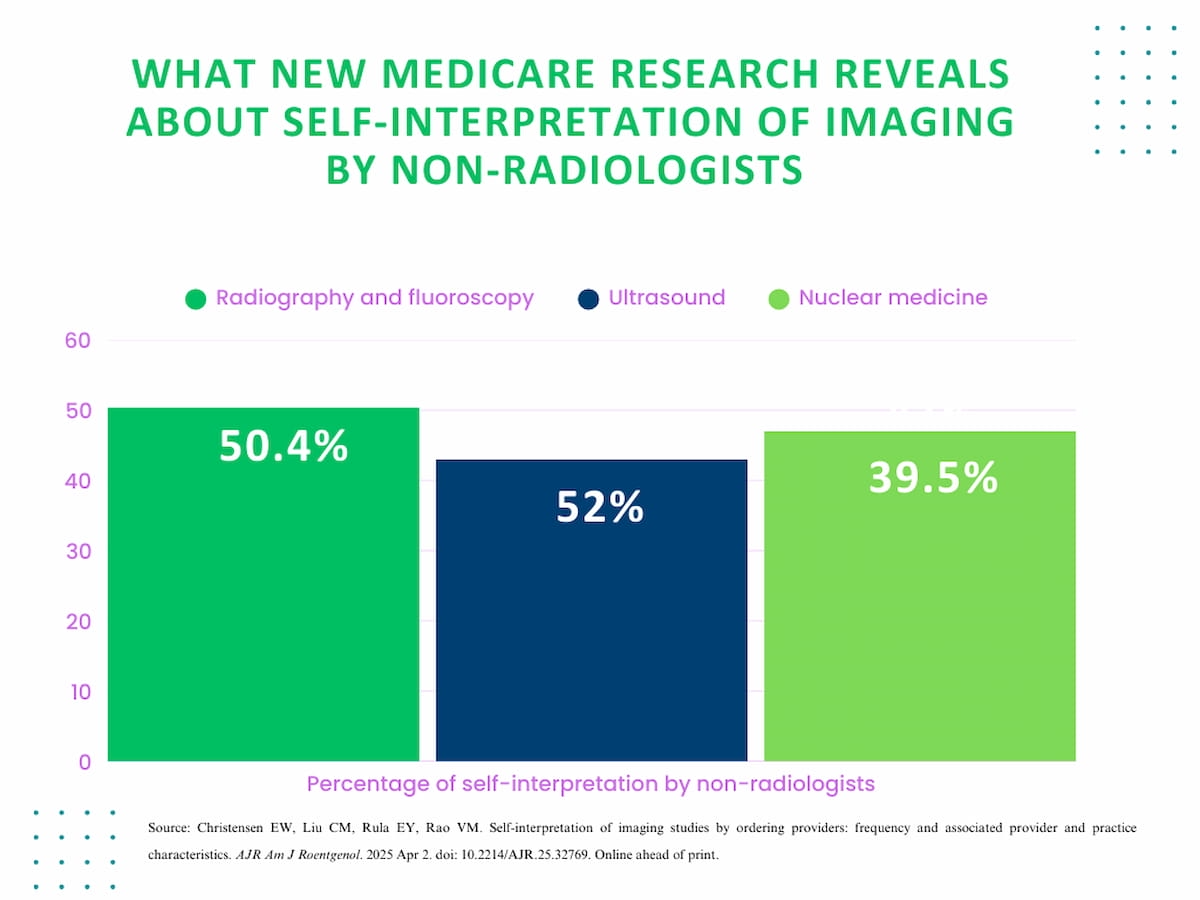Over half of claims for radiography and fluoroscopy, over half of claims for ultrasound and nearly 40 percent of claims for nuclear medicine were self-interpreted by non-radiologists, according to a new study of Medicare fee-for-service (FFS) non-breast imaging claims from 2022.
For the retrospective study, recently published in the American Journal of Roentgenology, researchers reviewed claims for imaging performed for 1,632,212 Medicare fee-for-service beneficiaries, and compared rates of self-interpretation by non-radiologists, within-practice interpretation, and radiologist interpretation.
Overall, the study authors found that self-interpretation of imaging by ordering providers occurred 43.6 percent of the time while radiologist interpretation occurred in 36.4 percent of the reviewed Medicare claims.
Specifically, the researchers noted self-interpretation accounted for 50.4 percent of claims for radiography and fluoroscopy; 52 percent of ultrasound claims; and 39.5 percent of claims for nuclear medicine imaging.
“Imaging interpretation by non-radiologists presents an important patient care issue in that non-radiologist specialties, aside from cardiology, lack the rigorous and comprehensive training in imaging interpretation that occurs during the 4 years of a radiology residency program,” wrote lead study author Eric W. Christensen, Ph.D., the senior director of economic and health services research at the Harvey L. Neiman Health Policy Institute in Reston, Va., and colleagues.
The study authors noted the overall within-practice interpretation rate was 58.5 percent. For those providers with a radiologist at their practice, the researchers said the self-interpretation rate was 69.1 percent vs. 55.4 percent for providers with no radiologist within the practice. There was also a significant disparity across practice sizes with in-house radiology interpretation of X-rays (a range between 24.9 to 61.1 percent) versus practices without a radiologist (15.5 to 36.2 percent), according to the researchers.
“The potential role of radiologist access in contributing to self-interpretation by non-radiologists highlights a potential implication of the ongoing national radiologist shortage on radiologic care. The associations related to the presence of a within-practice radiologist are also relevant to the current trend of increasing health-care consolidation. If such consolidation occurs in a multispecialty fashion that includes radiology, then such centralization may encourage referral of imaging services to the within-practice radiologist in lieu of potential self-interpretation,” posited Christensen and colleagues.
Three Key Takeaways
1. High rate of self-interpretation by non-radiologists. Over half of imaging claims for radiography, fluoroscopy, and ultrasound, and nearly 40 percent of nuclear medicine claims, were self-interpreted by non-radiologists. Overall, self-interpretation by ordering providers occurred in 43.6 percent of cases, surpassing radiologist interpretation at 36.4 percent.
2. Impact of radiologist access and health-care consolidation.
The presence of a radiologist within a practice influenced self-interpretation rates. Practices with a radiologist had a higher self-interpretation rate (69.1 percent) compared to those without (55.4 percent). The study also highlighted how ongoing radiologist shortages and healthcare consolidation trends could further shape radiologic care access.
3. Legal and policy considerations. The Stark law’s in-office exception facilitates high rates of imaging self-interpretation as it weakens restrictions on self-referral. The study suggests that this has made the law largely ineffective in curbing self-referred imaging volumes.
The study authors also suggested that an in-office exception to the Stark law against self-referral is a key factor with non-radiologist imaging interpretation.
“This exception greatly weakens the law’s ability to restrict imaging self-referral, contributing to the presently observed high rates of imaging self-interpretation. Indeed, studies have found that the law has been largely ineffective in achieving its aim, with comparable volumes of self-referred imaging observed before and after its enactment,” added Christensen and colleagues.
(Editor’s note: For related content, see “New Study Shows Non-Radiologists Interpreting 28 Percent of Imaging for Medicare Patients,” “Radiology Study Finds Increasing Rate of Non-Physician Practitioner Image Interpretation in Office Settings” and “The Rise of NPP Image Interpretation: What New Radiology Research Reveals.”)
In regard to study limitations, the authors noted the research was based solely on claims data over the course of one year for Medicare fee-for-service beneficiaries. While providers associated with multiple practices were only included in the study, the researchers pointed out that only one practice’s data was assessed for multiple practice providers. The study authors also conceded an inability to form associations between self-interpretation with quality and outcomes.
